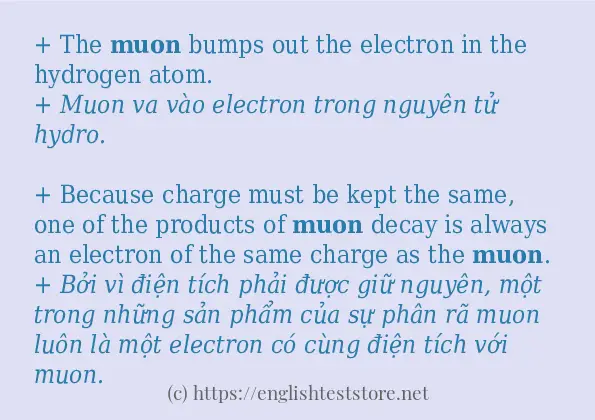Các cách sử dụng từ “muon”:
+ The muon bumps out the electron in the hydrogen atom.
+ Muon va vào electron trong nguyên tử hydro.
+ Because charge must be kept the same, one of the products of muon decay is always an electron of the same charge as the muon.
+ Bởi vì điện tích phải được giữ nguyên, một trong những sản phẩm của sự phân rã muon luôn là một electron có cùng điện tích với muon.
+ Therefore, there is an electron antineutrino, a muon antineutrino, and tau antineutrino.
+ Do đó, có một phản neutrino electron, một phản neutrino muon, và phản neutrino tau.
+ Because a muon is much more massive than an electron, the muon orbits much closer to the nucleus.
+ Bởi vì một muon có khối lượng lớn hơn nhiều so với một electron, nên muon quay quanh hạt nhân gần hơn nhiều.
+ Lederman and Jack Steinberger for their development of the neutrino beam method and their demonstration of the doublet structure of the leptons through the discovery of the muon neutrino.
+ Lederman và Jack Steinberger vì sự phát triển của phương pháp chùm neutrino và sự chứng minh của họ về cấu trúc kép của các lepton thông qua việc khám phá ra neutrino muon.
+ The dominant muon decay mode is the simplest possible: the muon decays to an electron, an electron-antineutrino, and a muon-neutrino.
+ Chế độ phân rã muon chiếm ưu thế là đơn giản nhất có thể: muon phân rã thành electron, electron-phản neutrino, và muon-neutrino.
+ A muon is like an electron, but it is 200 times heavier.
+ Một muon giống như một electron, nhưng nó nặng hơn 200 lần.
